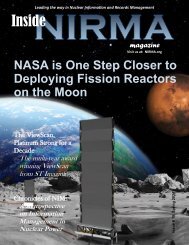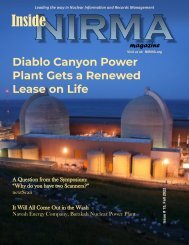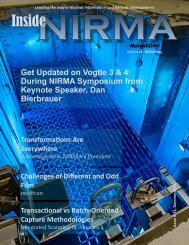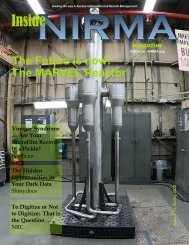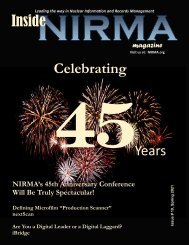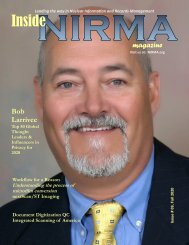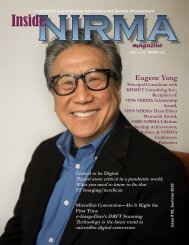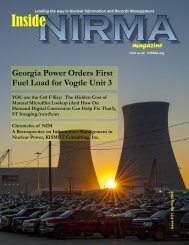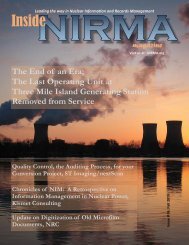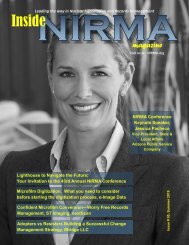Inside NIRMA Summer 2021
You also want an ePaper? Increase the reach of your titles
YUMPU automatically turns print PDFs into web optimized ePapers that Google loves.
would set a precedent that other utilities/plants could<br />
take advantage of, or 2) insert electronic records<br />
guidance into a subsequent version of NQA-1 (more on<br />
that later).<br />
Duke Energy Safety Evaluation Report Request<br />
In March 2015, Duke Energy Carolinas submitted a<br />
request to the NRC to approve a change to the Quality<br />
Assurance Topical Report (QATR) for its three nuclear<br />
stations. The request was to revise the QATR to<br />
reference the 2011 versions of the TGs. The NRC<br />
found it acceptable that the requirements of 10 CFR 50<br />
Appendix B would still be satisfied through compliance<br />
with the TGs. Therefore, the Duke SER satisfied one<br />
of the alternatives cited in the PP06 position paper.<br />
Bottomline: If you want to have electronic records management for<br />
your site, the NRC approves the use as long as your electronic<br />
records comply with these 2011 versions of the TGs.<br />
[On the <strong>NIRMA</strong> website, for these TGs, you will<br />
find a folder called “NRC-SER Endorsed <strong>NIRMA</strong> TGs<br />
(2011)” under the Technical Guidelines section of the<br />
Reference Documents area.]<br />
Regulatory Guide 1.28, Revision 5<br />
Quality Assurance Program Criteria<br />
(Design and Construction)<br />
In October 2017, the NRC issued Revision 5 of<br />
Regulatory Guide 1.28. Prior to that, in Revision 4, the<br />
NRC stated that, if electronic QA records were being<br />
stored and managed, its position on electronic records<br />
was based on Generic Letter 88-18 and RIS 2000-18<br />
that references the 1998 <strong>NIRMA</strong> guidelines (TG-11, TG<br />
-15, TG-16, TG-21). In Revision 5, the NRC stated:<br />
“For the management of electronic records,<br />
appropriate controls on quality assurance include the<br />
following:<br />
(a) No deletion or modification of records unless<br />
authorized pursuant to the record retention rule<br />
(b) Redundancy (system backup, dual storage, etc.) is<br />
provided<br />
(c) Legibility is required of each record<br />
(d) Records media are properly maintained<br />
(e) Inspections to ensure no degradation of records<br />
(f) Records are acceptably converted into any new<br />
system before the old system is taken out of<br />
service<br />
The Nuclear Information and Records Management<br />
Association (<strong>NIRMA</strong>) technical guides (TGs), as<br />
listed…, provide guidance to establish the<br />
appropriate quality controls that incorporates the<br />
implementation of enterprise content management<br />
systems, web-based technologies, and higher capacity<br />
LAN/WAN networks. The NRC approves for use<br />
the 2011 versions of the <strong>NIRMA</strong> TGs.”<br />
Bottomline: The NRC, in Revision 5, essentially leveraged its<br />
position stated in the Duke SER and approves the use of the<br />
2011 <strong>NIRMA</strong> TGs.<br />
American Society of Mechanical Engineers:<br />
Quality Assurance Requirements for<br />
Nuclear Facility Applications<br />
<strong>NIRMA</strong> members, in 2015, began to participate in<br />
the Programs Management Process (PMP)<br />
Subcommittee of NQA-1. It was surmised that the<br />
<strong>NIRMA</strong> TG content is very extensive, but wordy, so<br />
<strong>NIRMA</strong> TG (2011) requirements were reduced or<br />
summarized to fit the ASME NQA-1 format and scope.<br />
The advantages for the industry are that the<br />
manufacturers can use these changes very quickly; NSSS<br />
vendors and new build facilities can adjust, as needed.<br />
ASME NQA-1 is the “go-forward” strategy for industry<br />
and NRC review. It will not be tied to any specific TG<br />
version, so the standard can adjust as technology<br />
changes. From a <strong>NIRMA</strong> perspective, there will be<br />
many ASME interpretations, of which answers can then<br />
be sought in the full <strong>NIRMA</strong> TGs.<br />
Bottomline: The electronic records requirements are published as<br />
part of ASME NQA-1-2017. (Caution: You have to be<br />
committed to/and use this standard/year to take advantage of<br />
this.)<br />
Whew! Thanks for hanging in there with me. It’s<br />
been quite a ride in guidance space for over 30+ years,<br />
and <strong>NIRMA</strong> has been in the thick of it! In future<br />
columns, I intend to continue with addressing the other<br />
aspects of nuclear electronic records, such as<br />
authentication, sustainability, disaster planning and<br />
recovery, and more! Stay tuned!<br />
Eugene has been a member of <strong>NIRMA</strong> for over<br />
34 years. At the time he joined, <strong>NIRMA</strong> had<br />
only been in existence for 11 years. He would love<br />
to hear about stories and anecdotes from others, so<br />
please email him at eugene.yang@kismetconsulting.com.<br />
Back to Content | <strong>Inside</strong> <strong>NIRMA</strong> <strong>NIRMA</strong>.org <strong>Summer</strong> <strong>2021</strong> 25



